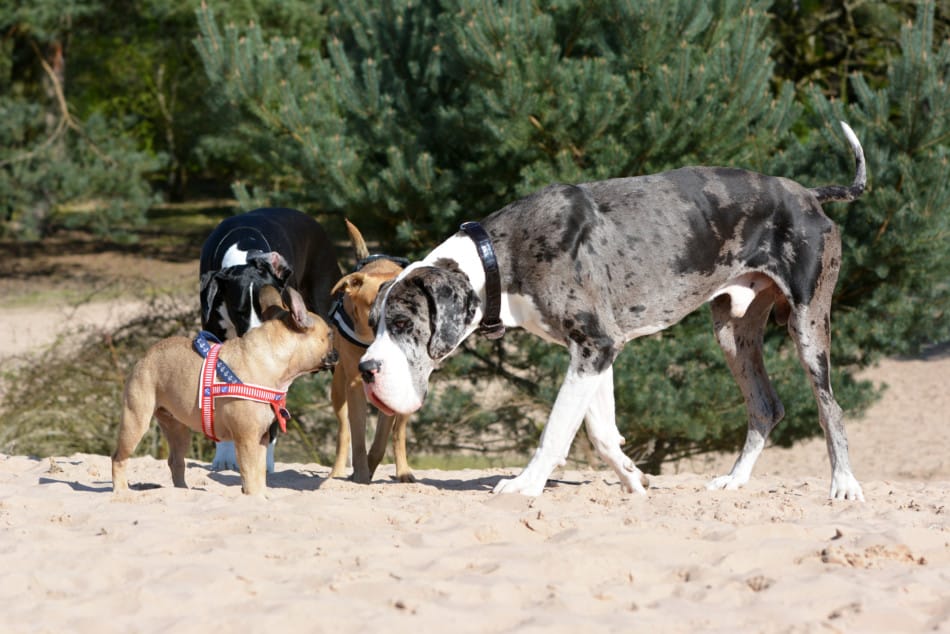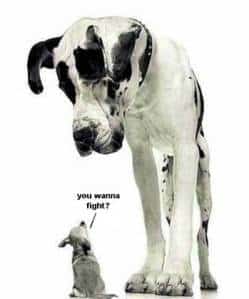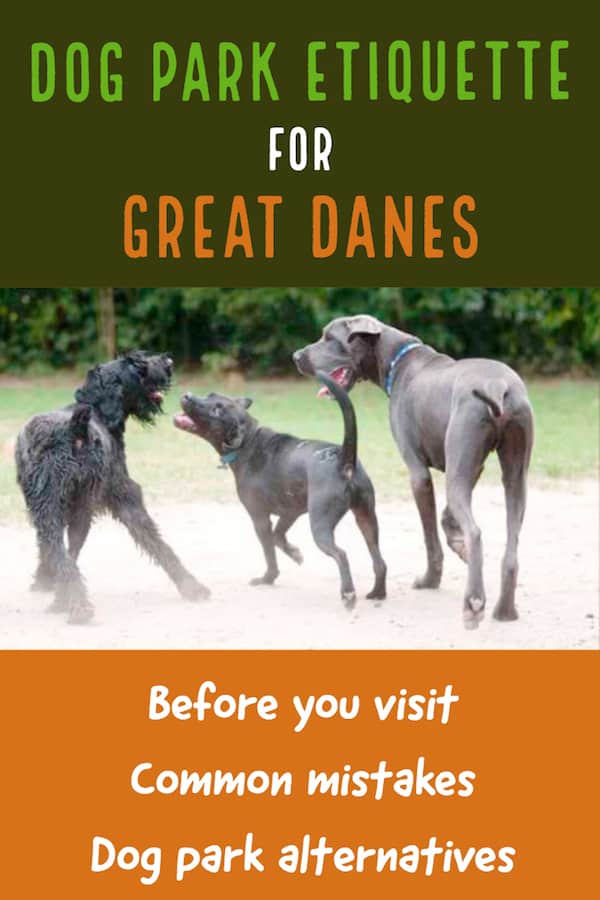
Before getting a Great Dane every prospective pet owner dreams of spectacular fun-filled trips to the dog park. Visions commonly include epic frisbee tosses and dog piles of irresistibly cute puppies playing nicely together.
Unfortunately – the reality is that your dog park experience can range from great to downright disturbing! And in many cases, dog owners are actually responsible for the issues thanks to their aloof nature or irresponsible actions.
The good news is that there are several steps that you can take to prevent these trips from being a negative experience. This applies to both you and your dog, as well as anyone else attending the dog park.
Before You Visit The Dog Park!
Tempting as it might be, there are a few items that you should address before your first visit to the dog park. Hopefully none of these are a surprise, but it’s better to be better safe than sorry!
1. Vaccinations
Before visiting the dog park, it’s critical to make sure that your dog is up to date on their vaccinations. If your Great Dane is a puppy, know that they should not visit the dog park until they’ve completed their basic vaccination schedule. These are
Given the high number of dogs that visit most dog parks, the risk of disease is just too high to chance a visit when not properly vaccinated. It’s not uncommon for diseases like parvovirus, distemper, rabies, kennel cough, and canine influenza to float around dog parks.
Staying up to date with vaccines also applies to older dogs. Annual boosters are common for rabies and DHPP/DHLPP. Remember – these aren’t just to protect other dogs but yours as well!
2. Basic Training
While you’re waiting for those vaccines to complete, you might as well make good use of that time! The next act you can take as a responsible Great Dane owner is to get them started with basic training. Commands such as sit and come (recall) are critical for ensuring that your dog has a fun and safe experience.
Believe me when I say that everyone resents the owner of the rogue dog at the dog park. Worst yet, you could even risk legal action should your giant dog accidentally injure someone. If you’re not sure where to start with training, take a look at our article on an introduction to Great Dane training.
3. Socialization
Just because your dog can’t visit the dog park yet doesn’t mean that you shouldn’t begin socializing them. Allow your dog to spend time in a controlled setting with a friend’s dog whom you know is well trained and mild mannered.
These small group settings will allow your Great Dane to learn how to properly act around other dogs. This is especially important if your dog is a puppy who otherwise will have only had the brief company of their littermates to learn these critical social skills.
If you’re working with an older Great Dane, these interactions will still be valuable so that you have a baseline understanding of how they act around other dogs.
This knowledge will make it easier for you to recognize any abnormal behavior when you do visit the park.
Your First Visit(s) To The Dog Park
Unless you were taught how to swim by being thrown into the ocean then it’s probably best not to introduce your dog to the dog park in a similar fashion. Visit the park during off hours until your Great Dane is familiar with the dog park experience.
Initially, try to avoid the parks busiest hours. These usually occur after-work during the weekdays and anytime during the weekend.
You can make quick trips to the park without your dog at varying times/days to better gauge the busy times at your parks.
Visits during off-peak hours will allow your dog to socialize with a smaller group of dogs and avoid overwhelming them. As they grow accustomed to dog park visits, you can start making trips during peak hours.
Know that peak hours will inevitably bring more chaos, so get ready for the potential mayhem to ensue!
Follow All Leash Guidelines

On-leash Areas
While it may seem silly that I have to cover this one, I can’t tell you how many times I see it go wrong! Even at off-leash dog parks, all require you to keep your Great Dane on-leash until reaching the designated off-leash area.
This is implemented for safety reasons, but virtually every single time we go to the dog park I see a dog off-leash in the parking lot (or similar area).
No matter how much you trust your dog, it will always be safer to keep them on-leash in this scenario. Even the best-trained dog could be injured or even killed by a distracted driver.
Off-leash Areas
Once reaching the off-leash area it’s important to actually take your dog off the leash! Once again, this is a mistake that I see far too often at dog parks and it often unfolds something like this…
After moving through the entry gate the owner and dog enter the off-leash area. Instead of removing the dog’s leash, the owner tries to quickly shuffle away from the entryway. Pulling along their very nervous-looking dog along for the ride.
Before making it even 15 feet away the dog and owner a swarmed by a pack of excited strange dogs. The owner anxiously tries to shoo away the dogs who are all trying to sniff, lick, or jump on them. The owner’s dog cowers around their owner’s legs. The dog lets out a yelp of fear and begs their owner to save them. Even worse, they may lunge in aggression towards the other dogs in an attempt to drive them away.
The owner and dog give up then and exit the park, or are hounded by various dogs in a similar manner for the rest of the visit.
While this story may sound like an exaggeration, I’ve seen this exact scenario play out too many times. Keeping your dog on-leash tells them that you don’t trust them to be off-leash, but it also limits their ability to interact with other dogs.
Much of the communication between dogs is done through body language. By keeping your dog on-leash, you limit their ability to express themselves to other dogs there.
If you’re still not convinced, listen to this little factoid! Research has shown the dogs demonstrate less aggressive behavior when off-leash, and are better able to socialize in environments like a dog park.
Did you catch that?
Taking them off leash actually creates less aggressive behavior because they feel more comfortable when not encumbered by a leash.
Common Mistakes Around The Entry/Exit

Another fantastic feature of modern dog parks is the use of double gates for entryways.
This allows you to enter the holding area with your dog on-leash, remove their leash, and then allow them to enter the off-leash area.
As simple as this sounds, there are a number of mistakes that I repeatedly see being made.
1. Be respectful of others entering and exiting
While you certainly want to make the most of your time at the dog park, there’s no need to bullrush the entryway. Be respectful of those already entering/exiting and allow them to complete their own process before barging in.
The last thing you want to do is accidentally let another dog escape off-leash and dart into an unsafe area.
Being that most dogs at the park will be strangers, there’s no need to cram them into the holding area together at the same time. These spaces are often small, and can lead to confrontation when put in such close quarters.
2. Shut the gates!
Yes, you can call me Captain Obvious. However, that doesn’t excuse those who constantly get this part wrong! As simple as it sounds, the gates are there to keep dogs both in and out of the park.
When you enter the first gate, make sure to completely shut it behind you before removing your dog’s leash. Don’t leave it open because you see another owner and dog approaching.
You have no idea if they intend to enter the park right away, or in 15 minutes. So shut the gate!
Next, remove your dog’s leash and immediately lead them to the second gate. Open the gate and allow them to enter the off-leash portion of the park. Swiftly step inside and close the gate behind you.
Dogs often congregate near the entrance to “greet” new visitors and may even attempt to push past the gate. Therefore, making it doubly important that you have fully shut the first gate as previously mentioned.
3. Don’t linger in the holding area
You may have missed this detail in the previous section, so I’ll cover it more explicitly. The purpose of the holding area is to create a safe environment for your Great Dane to enter or exit the park.
Because it’s used by every single dog entering and exiting the park, it’s not a good spot to “hang out”.
Be respectful of others and move as efficiently as possible through this area to avoid making them wait. Simply put, your steps are: enter the holding area, lock the first gate, remove your dog’s leash, enter the park, lock the second gate.
If you think your dog needs more time to calm down before entering the park, do so in the on-leash area outside of the dog park.
You’re only asking for trouble in the form of confrontation or escaped dogs by spending more time in the holding area than necessary.
Stay In Your Lane

This should already be obvious, but your Great Dane is quite the large dog. One of the largest in fact! When dog parks do offer the option of large and small dog areas, make sure to keep your Great Dane in the large dog portion.
While your Great Dane may act like a giant baby at times, the small dog park is no place for them. Regardless of their age, their comparatively massive size is probably terrifying to the small pups.
While you don’t intend to scare them, bringing your Great Dane into this section is only asking for a confrontation.
The likelihood of your Great Dane accidentally injuring a small dog is also much higher. Unless you find paying extra vet bills exciting, it’s yet another reason to stick to the big dog area.
Pay Attention

As alluded to in the intro, owners are to blame for many of the issues at dog parks. So put down your cellphone, don’t worry about chatting up that cute boy or girl, and watch your dog!
To be clear – I’m not advocating being a helicopter pet-parent. However, there is a big difference between hovering and just being irresponsible.
Lets dive into some common examples!
1. Pick up your dog’s pooooooooop
If you think everyone won’t figure out that it’s your dog’s poop then you’re very wrong. That hulking pile is unmistakably a Great Dane’s dirty business, so please be considerate of others and dispose of it.
Aside from the social embarrassment of being called out, you should take it upon yourself as a patron of the dog park to keep it clean. No one wants to spend their day at the dog park dodging land mines!
If you’re feel the need to collect a few extra karma points, you can also pick up some other lost treasures as well.
Also, make sure to bring poop bags of your own as there’s no guarantee that your park will have some available. There’s also an equally likely chance that they won’t be large enough for the job 😉
2. Don’t let your dog steal toys from other dogs
Your Great Dane’s size may very well intimidate other dogs. As such they may unintentionally steal toys from other dogs in attempts to play. Innocent play or not, don’t let this become a habit!
Aside from accidental bullying, dogs can be very territorial when it comes to their toys. Unfortunately this often results in bites or fighting between dogs. Pay attention to dog’s social queues to see if they’re playing nicely or not.
“Nice” play usually takes the form of a give and take rather than one dog dominating the other. If you see them getting upset or anxious it’s time to take the party elsewhere!
3. Don’t let your dog injure others
This note goes for both humans and canines. Your dog will very likely be the largest at the park, and as such they need to act accordingly. Normal play is absolutely ok, but rough-housing on the other hand is not.
Not only do you not want to seem them injure anyone else, but doing so could actually result in legal implications.
With Great Dane’s comes great responsibility! So pay attention and take charge of a situation if it does present itself. Don’t sit back and expect others handle it for you.
Dog Park Alternatives
From your dog’s point of view, the key benefit of a dog park is the exercise and socialization. However, if your dog finds this experience overwhelming or it just doesn’t fit their personality, don’t feel like it’s your only option.
Taking your dog to play with a small group of friends and their dogs, going on a long walk or hike, or even just out an outing to a dog friendly public area can also meet their needs.
The key is in finding ways that suit them to provide the necessary stimuli for a happy Great Dane. Feel free to get creative and enjoy your time with them!
Final Thoughts On Dog Parks
While all of the steps covered are very simple in their own right, it only takes the actions of a few irresponsible owners to ruin the dog park experience for everyone else.
Doing your small part will go a long to ensuring a positive experience for you and your Great Dane!


Thank you for explaining how important it is for a dog to be up to date on its vaccinations before going to the dog park. My sister-in-law wants to take her new Great Dane puppy to a park with us. I’ll show her this article and explain to her that it is not a good idea until he has gotten all of his vaccinations.
https://www.pgjdogbar.com/
How long can I take my 4 month old Dane to the dog park?
Nothing irks me more than when I take my Dane to the dog park, and go into the large dog area and it is full of small dogs that should be in their own area! I have been told they don’t take their dogs in the small dog area because either there are no dogs to play with, or their little Fluffy loves playing with big dogs.